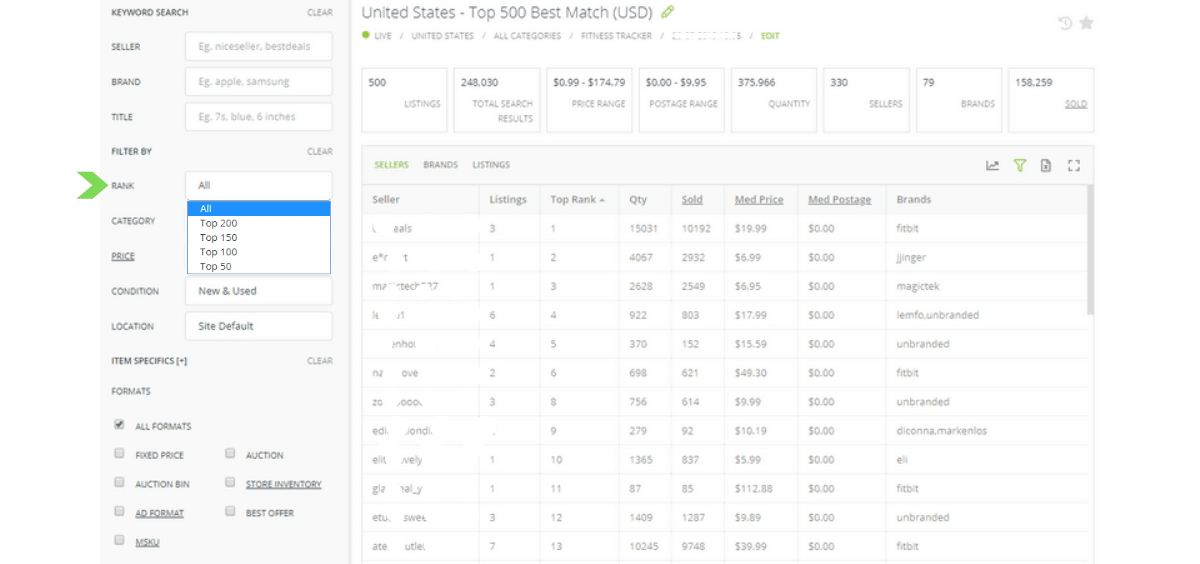On eBay, your competitive space is defined every time a buyer searches by keyword and your product listing gets called into the search results pages. Your competitors are battling it out for top rank while Best Match, eBay’s search algorithm, assesses buyer behaviour and recent sales data to sort products listings more relevant than others.
Prime position at the top of search results gives you first dibs to the buyer. This is where you want to be - and if you’re not, you will want to know who is ahead of you, what products are ahead of you, why are they ahead of you. And if you’re already at the top, you should be paranoid, who is out there vying for your position? What products are they selling? Who and what is rising in the ranks?
This is where ShelfTrend can be very useful.
Here are some tips on how to use ShelfTrend to build a bigger picture of your competitive space whilst also getting a better idea of the products and prices you are competing against.
Get a good look around.
Run a Top 500 Live Listings Report on your best performing product range. The Top 500 report offers a summary view of the first 10 page of search results - this is your battlefield. This is the part of eBay where Buyers will actively assess your product against others to make their purchase decision.
At the top of the Top 500 Live Listings report is the summary data section, observe:
The total number of product listings available on eBay for that product/keyword.
The price range of the Top 500 listing
The number of sellers and brands participating in the first 10 pages.
Explore the data by moving around the report. Sort columns by listings and price. Toggle in-and-out of Seller, Brand and Listings view. Click through to seller ids, brands and other values to deep dive into the data. For a different point of view, click through to the data visualisation to see the data in charts.
Uncover dominant players in the mix. There is a lot of insight to glean by analysing listing share by seller, brand, or subcategory. Best Match is fine tuned to predict and present the most relevant and sellable product listings to the buyer to secure a transaction. Behind the sophisticated algorithm is a massive feedback loop monitoring buyer interaction with product listings up and down the purchase funnel.
A dominant subcategory in top 500 means that buyer interactions have indicated a preference toward that product type. A dominant brand means it is getting the most buyer attention. A dominant seller – well, it means they got their product range right and the buyer is responding.
Pay attention to Best Match’s assortment mix. Its calculations are customer-focused and the way it merchandises gives hint to what could be trending on eBay right then and there, give it another week and it could be different again.
Profile the products your buyer will most likely see.
Filter rank to the Top 50. This represents page 1 of search results where more than 90% of sales are made for most search terms. This is the most critical part of the battlefield.
As you filter to the top 50, watch how the price range and the number of sellers participating in this elite part of the search results change. This is the pointy end of what Best Match deems as the most relevant products to the buyer.
Explore the data some more and toggle between the different rank options in the filter to see how the net of products gets wider. The top 100 represents the first 2 pages of search results.
Your competitive space is a dynamic online marketplace where eBay is shuffling product rank constantly to meet buyer demand. Prices are moving up and down. Sellers and their products are coming and going. Learning to monitor the way eBay merchandises gives you inside perspective to stay ahead of the game for any opportunities and threats coming your way.
As a next step, have a read of our 2016 study of iPhone covers, one of eBay’s fastest moving categories. ShelfTrend observed the day to day shuffle of merchandising favouring different types of iPhone covers from crystal to shockproof to wooden to leather. The only explanation for this type of movement is a response to changing buyer preferences.


